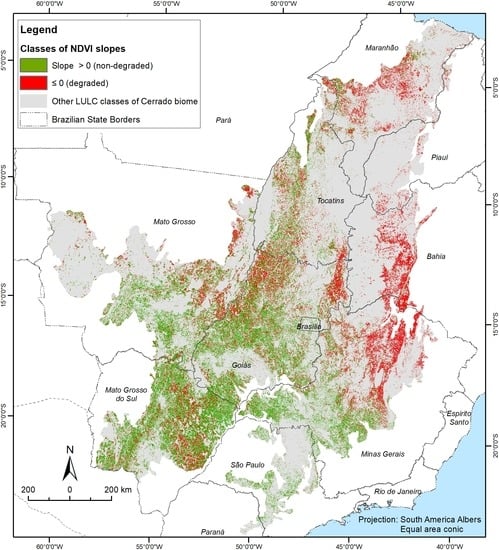Assessing Pasture Degradation in the Brazilian Cerrado Based on the Analysis of MODIS NDVI Time-Series
Abstract
1. Introduction
2. Study Area
3. Material and Methods
3.1. Datasets
3.2. Methods
3.2.1. NDVI Cumulative Regression
3.2.2. Mapping Pasture Degradation
4. Results
4.1. Mapping Pasture Degradation in the Cerrado Based on Field Sample Data
4.2. Status of Pasture Degradation in the Cerrado and Correlation with Other Variables
5. Discussion
6. Conclusions
Author Contributions
Funding
Acknowledgments
Conflicts of Interest
References
- Agard, J.; Alcamo, J.; Ash, N.; Arthurton, R.; Barker, S.; Barr, J.; Baste, I.; Chambers, W.B.; Dent, D.; Fazel, A.; et al. Global Environment Outlook: Environment for Development; EarthPrint, UNEP: Nairobi, Kenya, 2007; pp. 1–407. ISBN 9789280728361. [Google Scholar]
- Aguiar, D.A.; Mello, M.P.; Nogueira, S.F.; Gonçalves, F.G.; Adami, M.; Theodor Rudorff, B.F. MODIS time series to detect anthropogenic interventions and degradation processes in tropical pasture. Remote Sens. 2017, 9, 73. [Google Scholar] [CrossRef]
- Eswaran, H.; Lal, R.; Reich, P.F. Land degradation: An overview. Response to Land Degradation. In Proceedings of the 2nd International Conference on Land Degradation and Desertification; Oxford Press: New Delhi, India, 2001; pp. 20–35. [Google Scholar]
- Lal, R. Soil Erosion and Land Degradation: The Global Risks. In Advances in Soil Science; Lal, R., Stewart, B.A., Eds.; Springer: New York, NY, USA, 1990; Volume 11, p. 345. [Google Scholar]
- Wiegmann, K.; Hennenberg, K.J.; Fritsche, U.R. Degraded land and sustainable bioenergy feedstock production. In Proceedings of the Workshop on High Natural Value Criteria and Potential for Sustainable Use of Degraded Lands, Paris, France, 30 June–1 July 2008. [Google Scholar]
- Dias-Filho, M.B. Degradação de Pastagens: Processos, causas e estratégias. In Degrad. Pastagens Process. Causas e Estratégias; Embrapa Amazônia Oriental: Belém, Brazil, 2005; pp. 1–173. ISBN 978-85-911831-0-4. [Google Scholar]
- Barrow, C. Land Degradation: Development and Breakdown of Terrestrial Environments; Cambridge University: New York, USA, 1991; pp. 1–313. ISBN 9780521466158. [Google Scholar]
- Gibbs, H.K.; Salmon, J.M. Mapping the world’s degraded lands. Appl. Geogr. 2015, 57, 12–21. [Google Scholar] [CrossRef]
- Bot, A.J.; Nachtergaele, F.O.; Young, A. Land Resource Potential and Constraints at Regional and Country Levels; World Soil Resources Reports; Food and Agriculture Organization (FAO): Rome, Italy, 2000; pp. 1–114. [Google Scholar] [CrossRef]
- Dregne, H.E.; Chou, N.T. Global desertification dimensions and costs. In Degradation and Restoration of Arid Lands; Texas Tech University: Lubbock, TX, USA, 1992; pp. 73–92. [Google Scholar]
- Oldeman, L. The global extent of soil degradation. In Soil Resilience and Sustainable Land Use; CAB International: Wallingford, UK, 1994; pp. 19–36. [Google Scholar]
- Bai, Z.G.; Dent, D.L.; Olsson, L.; Schaepman, M.E. Proxy global assessment of land degradation. Soil Use Manag. 2008, 24, 223–234. [Google Scholar] [CrossRef]
- Cai, X.; Zhang, X.; Wang, D. Land availability for biofuel production. Environ. Sci. Technol. 2011, 45, 334–339. [Google Scholar] [CrossRef] [PubMed]
- Campbell, J.E.; Lobell, D.B.; Field, C.B. Greater transportation energy and GHG offsets from bioelectricity than ethanol. Science 2009, 324, 1055–1057. [Google Scholar] [CrossRef] [PubMed]
- Field, C.B.; Campbell, J.E.; Lobell, D.B. Biomass energy: The scale of the potential resource. Trends Ecol. Evol. 2008, 23, 65–72. [Google Scholar] [CrossRef] [PubMed]
- Eiumnoh, A. Tools for identification, assessment, and monitoring of land degradation. In Response to Land Degradation; Bridges, E.M., Hannam, I.D., Eds.; Oxford & IBH Publishing: New Delhi, India, 2001; Volume 22, pp. 1–507. ISBN 1-57808-153-X. [Google Scholar]
- Symeonakis, E.; Drake, N. Monitoring desertification and land degradation over sub-saharan Africa. Int. J. Remote Sens. 2004, 25, 573–592. [Google Scholar] [CrossRef]
- Wessels, K.J.; Prince, S.D.; Frost, P.E.; Van Zyl, D. Assessing the effects of human-induced land degradation in the former homelands of northern South Africa with a 1 km AVHRR NDVI time-series. Remote Sens. Environ. 2004, 91, 47–67. [Google Scholar] [CrossRef]
- Cohn, A.S.; Mosnier, A.; Havlik, P.; Valin, H.; Herrero, M.; Schmid, E.; O’Hare, M.; Obersteiner, M. Cattle ranching intensification in Brazil can reduce global greenhouse gas emissions by sparing land from deforestation. Proc. Natl. Acad. Sci. USA 2014, 111, 7236–7241. [Google Scholar] [CrossRef] [PubMed]
- Dias Filho, M.B. Diagnóstico das Pastagens No Brasil; Embrapa Amazônia Oriental: Belém, Brazil, 2014; p. 22. [Google Scholar]
- Instituto Brasileiro de Geografia e Estatística (IBGE). Censo Agropecuário 2006; IBGE: Rio de Janeiro, Brazil, 2009; p. 777. [Google Scholar]
- EMBRAPA. Geodegrad: Desenvolvimento de Geotecnologias para Identificação e Monitoramento de Níveis de Degradação em Pastagens. Available online: http://www.geodegrade.cnpm.embrapa.br/apresentacao (accessed on 3 May 2017).
- BNDES. Programa ABC (Agricultura de Baixo Carbono). Available online: https://www.bndes.gov.br/wps/portal/site/home/financiamento/produto/programa-abc (accessed on 1 February 2018).
- Gurgel, A.C.; Fagan, C.F.; Serigati, F.C. Agricultura de Baixa Emissão de Carbono: A Evolução de um novo Paradigma; Observatório ABC; Fundação Getúlio Vargas/Centro de Agronegócio da Escola de Economia de São Paulo: São Paulo, Brazil, 2013; p. 192. [Google Scholar]
- Tasumi, M.; Hirakawa, K.; Hasegawa, N.; Nishiwaki, A.; Kimura, R. Application of MODIS Land Products to Assessment of Land Degradation of Alpine Rangeland in Northern India with Limited Ground-Based Information. Remote Sens. 2014, 6, 9260–9276. [Google Scholar] [CrossRef]
- Instituto Brasileiro de Geografia e Estatística (IBGE). Mapa de Biomas e de Vegetação. Geociências. Mapa Biomas e Veg. 2015, 4. Available online: https://ww2.ibge.gov.br/home/presidencia/noticias/21052004biomashtml.shtm (accessed on 1 March 2018).
- Marcuzzo, F.; Melo, D.; Rocha, H. Distribuição Espaço-Temporal e Sazonalidade das Chuvas no Estado do Mato Grosso. Rev. Bras. Recur. Hídr. 2011, 16, 157–167. [Google Scholar] [CrossRef]
- Ferreira, L.G.; Huete, A.R. Assessing the seasonal dynamics of the Brazilian Cerrado vegetation through the use of spectral vegetation indices. Int. J. Remote Sens. 2004, 25, 1837–1860. [Google Scholar] [CrossRef]
- Ferreira, L.G.; Fernandez, L.E.; Sano, E.E.; Field, C.; Sousa, S.B.; Arantes, A.E.; Araújo, F.M. Biophysical properties of cultivated pastures in the brazilian savanna biome: An analysis in the spatial-temporal domains based on ground and satellite data. Remote Sens. 2013, 5, 307–326. [Google Scholar] [CrossRef]
- Parente, L.; Ferreira, L.; Faria, A.; Nogueira, S.; Araújo, F.; Teixeira, L.; Hagen, S. Monitoring the brazilian pasturelands: A new mapping approach based on the landsat 8 spectral and temporal domains. Int. J. Appl. Earth Obs. Geoinf. 2017, 62, 135–143. [Google Scholar] [CrossRef]
- Instituto Brasileiro de Geografia e Estatística (IBGE). Produção da Pecuária Municipal—PPM. Available online: https://www.ibge.gov.br/estatisticas-novoportal/economicas/agricultura-e-pecuaria/9107-producao-da-pecuaria-municipal.html?&t=o-que-e (accessed on 3 May 2018).
- Huete, A.; Didan, K.; Miura, T.; Rodriguez, E.P.; Gao, X.; Ferreira, L.G. Overview of the radiometric and biophysical performance of the MODIS vegetation indices. Remote Sens. Environ. 2002, 83, 195–213. [Google Scholar] [CrossRef]
- Solano, R.; Didan, K.; Jacobson, A.; Huete, A. MODIS Vegetation Index User’s Guide (MOD13 Series). In Vegetation Index and Phenology Lab; 2010; Available online: https://vip.arizona.edu/documents/MODIS/MODIS_VI_UsersGuide_June_2015_C6.pdf (accessed on 5 May 2018).
- LAPIG. PAVAN (Pasture Evaluation Network)—Points. Available online: http://maps.lapig.iesa.ufg.br/lapig.html (accessed on 3 September 2017).
- Funk, C.; Peterson, P.; Landsfeld, M.; Pedreros, D.; Verdin, J.; Shukla, S.; Husak, G.; Rowland, J.; Harrison, L.; Hoell, A.; et al. The climate hazards infrared precipitation with stations—A new environmental record for monitoring extremes. Sci. Data 2015, 2. [Google Scholar] [CrossRef] [PubMed]
- LAPIG. Lotação Bovina No Brasil. Available online: http://maps.lapig.iesa.ufg.br/lapig.html (accessed on 15 January 2018).
- Instituto Brasileiro de Geografia e Estatística (IBGE). Censo 2010. Available online: https://sidra.ibge.gov.br/pesquisa/censo-demografico/demografico-2010/inicial (accessed on 15 October 2017).
- Eckert, S.; Hüsler, F.; Liniger, H.; Hodel, E. Trend analysis of MODIS NDVI time series for detecting land degradation and regeneration in Mongolia. J. Arid Environ. 2015, 113, 16–28. [Google Scholar] [CrossRef]
- Ibrahim, Y.Z.; Balzter, H.; Kaduk, J.; Tucker, C.J. Land degradation assessment using residual trend analysis of GIMMS NDVI3g, soil moisture and rainfall in Sub-Saharan West Africa from 1982 to 2012. Remote Sens. 2015, 7, 5471–5494. [Google Scholar] [CrossRef]
- LAPIG. Mapa Síntese da Área de Pastagem (MSP) para o Território Brasileiro. Available online: http://maps.lapig.iesa.ufg.br/lapig.html (accessed on 3 August 2017).
- Al-Bakri, J.T.; Taylor, J.C. Application of NOAA AVHRR for monitoring vegetation conditions and biomass in Jordan. J. Arid Environ. 2003, 54, 579–593. [Google Scholar] [CrossRef]
- Bolfe, É.L.; Victória, D.; de, C.; Contini, E.; Bayma-Silva, G.; Spinelli-Araujo, L.; Gomes, D. Matopiba em crescimento agrícola Aspectos territoriais e socioeconômicos. Rev. Polít. Agríc. 2016, 24, 38–62. [Google Scholar]
- Instituto Brasileiro de Geografia e Estatística (IBGE). Censo Agropecuário 2017, 1st ed.; IBGE: Rio de Janeiro, Brazil, 2018; ISBN 0103-6157. [Google Scholar]
- INPE. Incremento Anual de área desmatada no Cerrado Brasileiro—PRODES. Available online: http://www.obt.inpe.br/cerrado (accessed on 10 March 2018).
- Bragança, A. Insights as Agricultural Production Surges in Matopiba, What Are the Consequences for the Local Economy? 2016. Available online: https://climatepolicyinitiative.org/publication/agricultural-production-surges-matopiba-consequences-local-economy/ (accessed on 29 August 2018).
- Campos, C.; Morais, L.; Sá, H.A. Que desenvolvimento é esse? Análise da expansão do agronegócio da soja na área do MATOPIBA a partir de uma perspectiva furtadiana. In Proceedings of the XXI Congresso Brasileiro de Economia, Curitiba, Brazil, 9–11 September 2015. [Google Scholar]
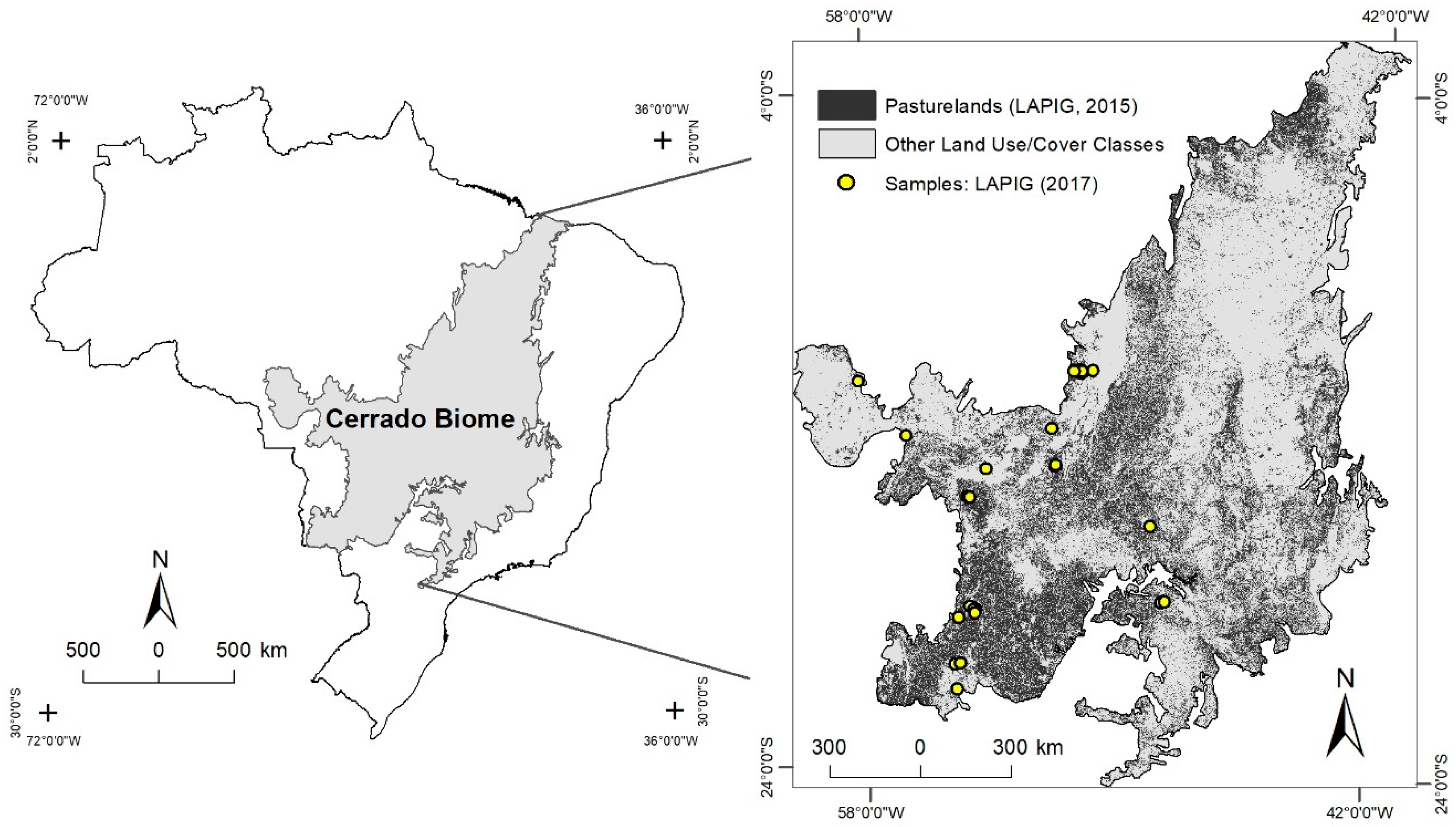
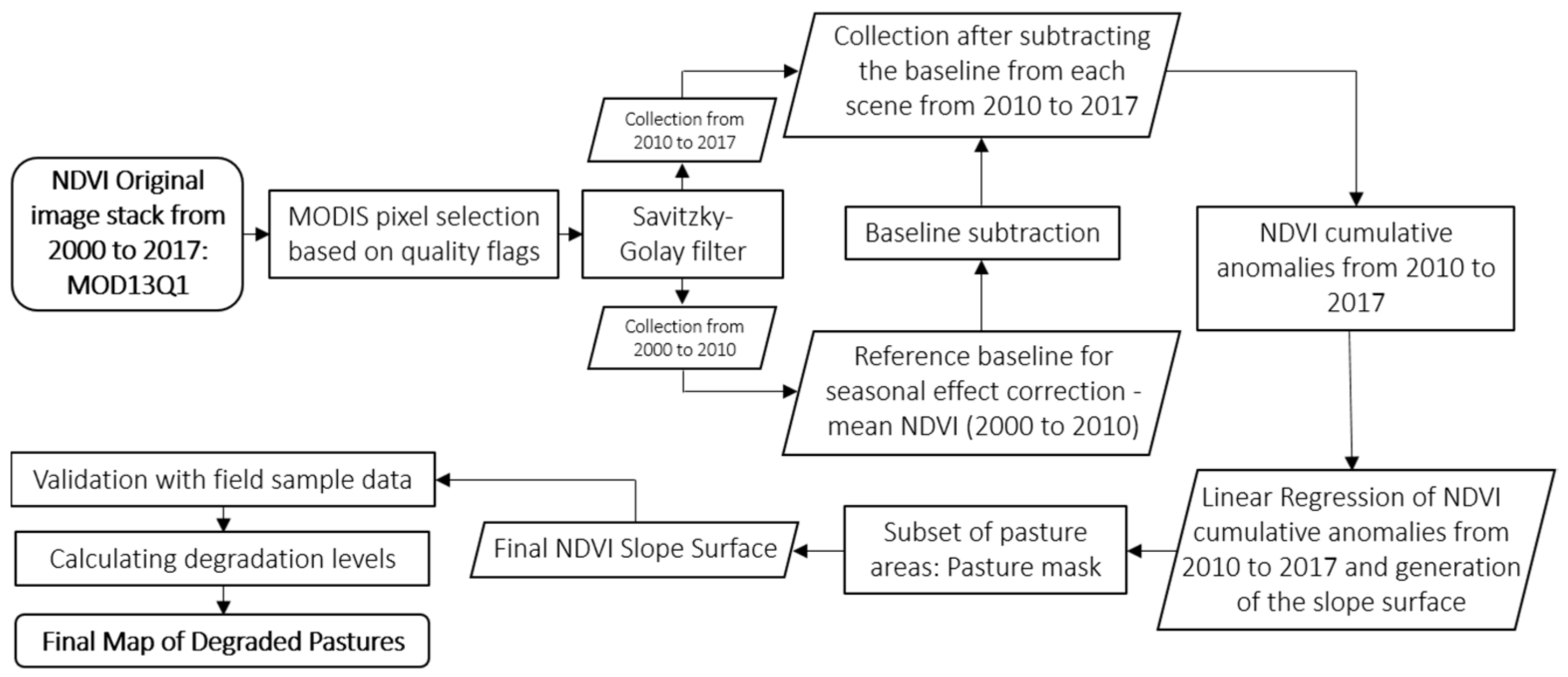
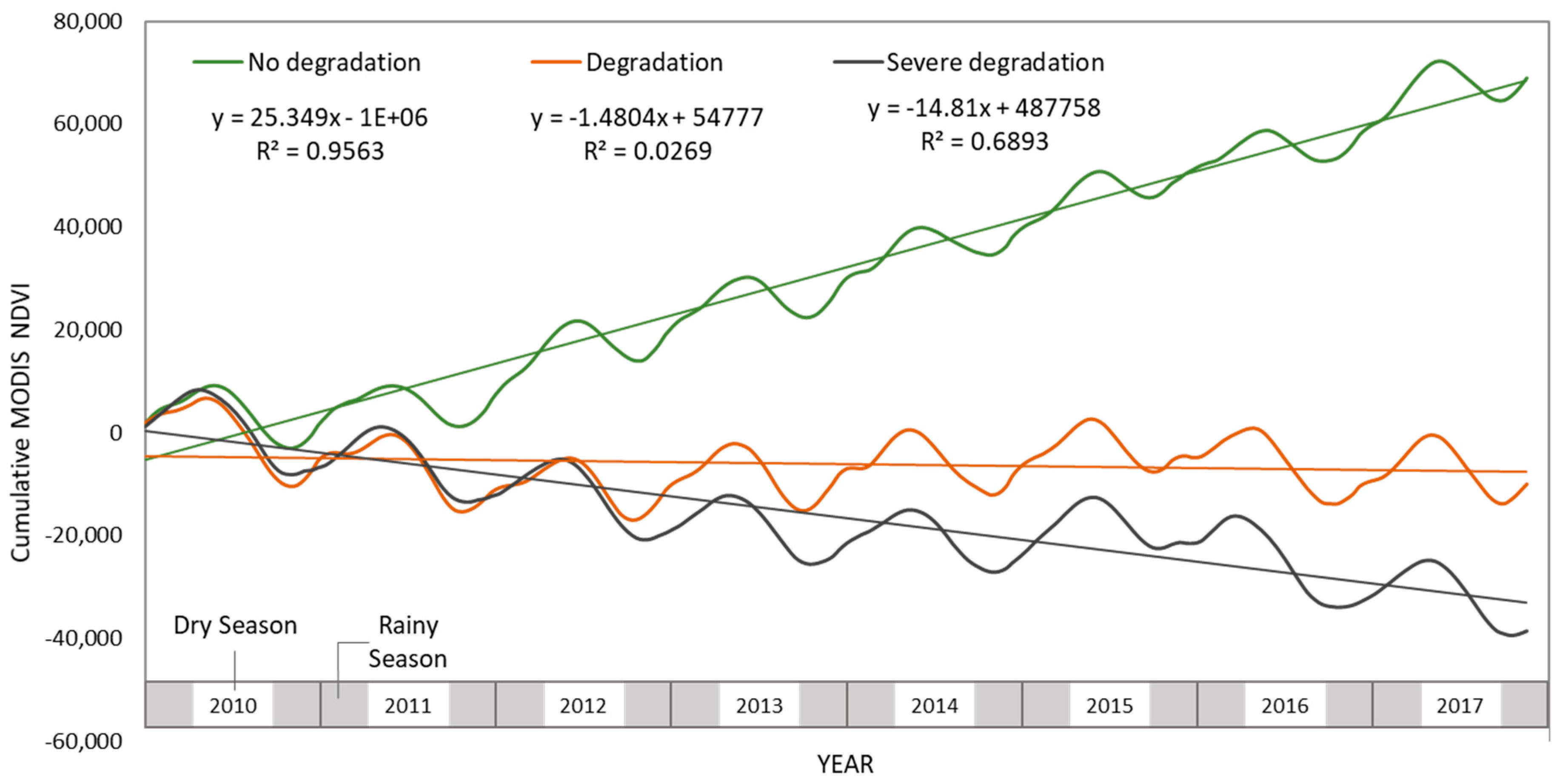
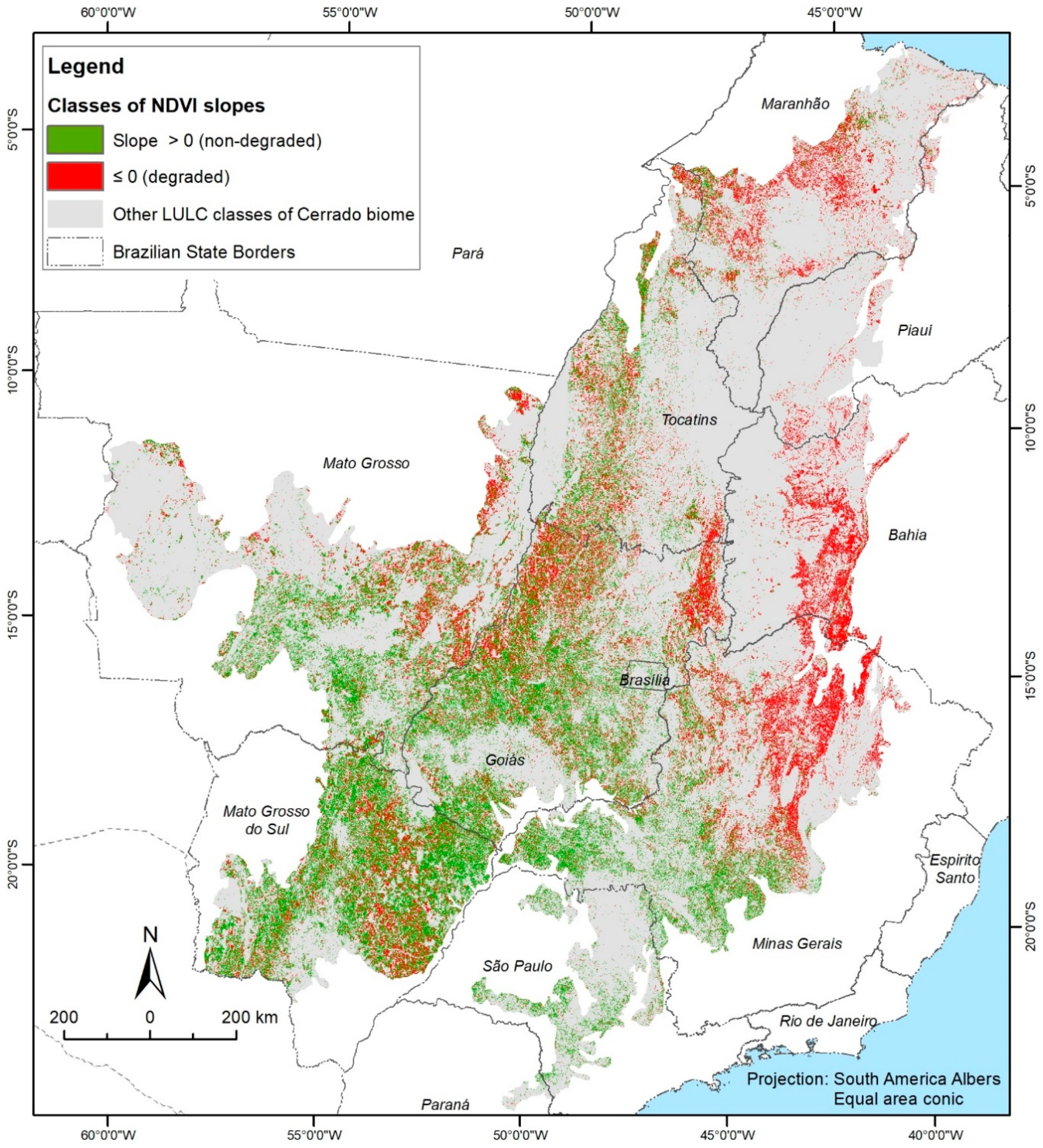
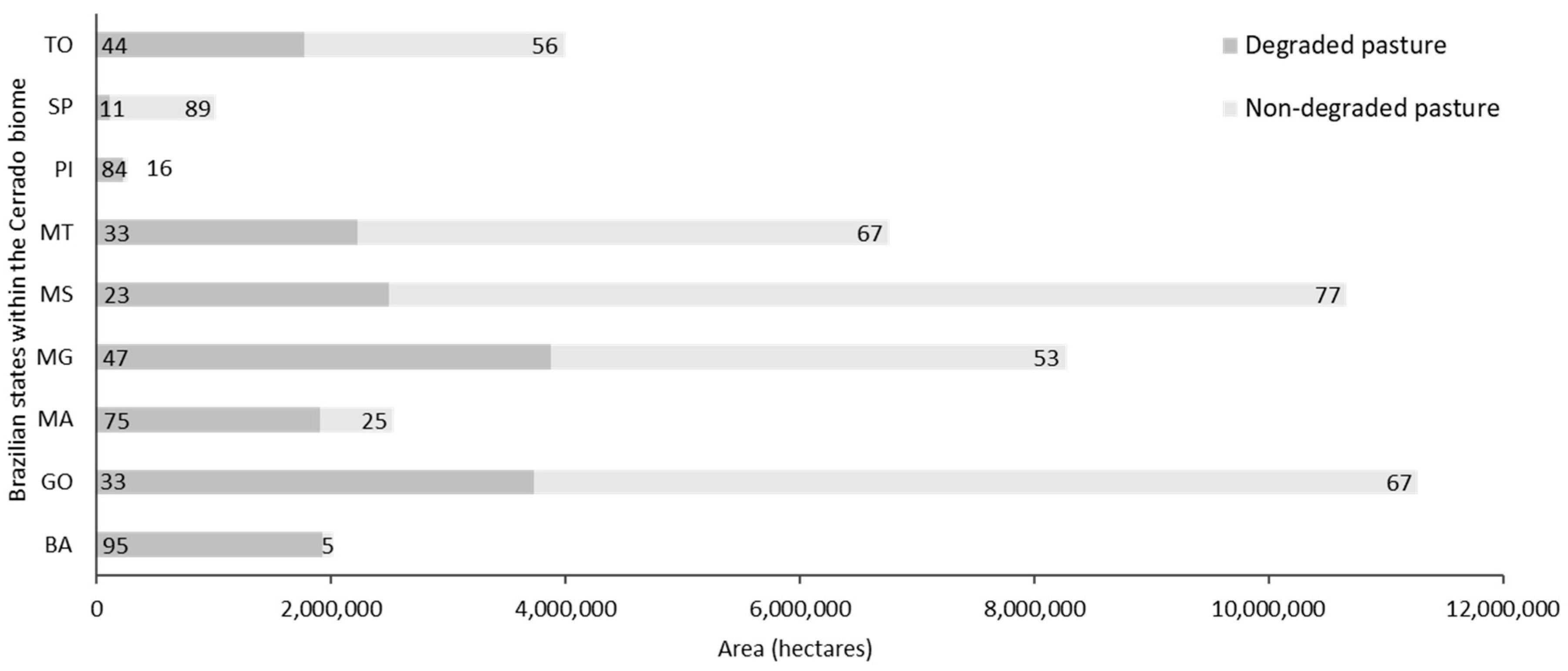
| ID * | Last Management | Management Type | Description | Stage ** | NDVI Slope |
|---|---|---|---|---|---|
| 175 | - | fertilization and limestone | Subsistence meat production | 0 | 53.67 |
| 171 | 2014 | fertilization and limestone | Yearly crop rotation—integrated system | 0 | 46.44 |
| 186 | 2013 | fertilization and limestone | Pasture in good condition | 0 | 33.08 |
| 35 | 2014 | crop rotation | Crop rotation every 5 years | 0 | 30.39 |
| 34 | - | fertilization and limestone | Pasture restored every 10 years | 0 | 28.72 |
| 177 | 2014 | fertilization and limestone | Used for sheep meat production | 0 | 20.48 |
| 214 | 2012 | fertilization and limestone | Yearly crop rotation—integrated system | 0 | 18.39 |
| 174 | - | fertilization and limestone | Subsistence milk production | 0 | 17.02 |
| 215 | 2013 | fertilization and mowing | Intensified beef production | 0 | 16.61 |
| 181 | 2014 | fertilization and limestone | Subsistence meat production | 0 | 15.72 |
| 184 | 2014 | fertilization and mowing | Used for sheep meat production | 0 | 9.76 |
| 176 | 2014 | organic fertilization | Subsistence milk production | 0 | 3.94 |
| 187 | 2011 | limestone | Pasture with termite proliferation | 1 | 17.76 |
| 217 | 1994 | No current management | Pasture with termite proliferation | 1 | 12.19 |
| 197 | 2014 | limestone | Subsistence meat production | 1 | −4.22 |
| 199 | Never | mowing | Subsistence meat production | 1 | −6.66 |
| 189 | 2000 | No Management | Used for beef and milk production | 1 | −7.18 |
| 196 | 2014 | No Management | Subsistence meat production | 1 | −20.81 |
| 62 | Never | No Management | Pasture with bare soil | 2 | 8.74 |
| 74 | Never | No Management | Pasture with bare soil | 2 | 2.88 |
| 193 | Never | No Management | Pasture with invasive species | 2 | −0.41 |
| 83 | Never | No Management | Pasture with bare soil | 2 | −2.59 |
| 5 | Never | No Management | Pasture with bare soil | 2 | −8.64 |
| 82 | Never | No Management | Pasture with bare soil | 2 | −10.13 |
| 64 | Never | No Management | Pasture with bare soil | 2 | −16.53 |
| 192 | Never | No Management | Used for beef and milk production | 2 | −22.72 |
| 190 | Never | No Management | Used for beef and milk production | 2 | −42.6 |
| 81 | Never | No Management | Pasture with bare soil | 2 | −56.15 |
| Animal Units (UA ha−1) | No Management Farms | Degraded Pastures (ha) | Degraded Pastures (%) | NDVI Slope | HDI | Rainfall Slope | |
|---|---|---|---|---|---|---|---|
| Animal Units (UA ha−1) | 1.00 | ||||||
| No management farms | −0.26 | 1.00 | |||||
| Degraded pastures (ha) | −0.31 | 0.73 | 1.00 | ||||
| Degraded pastures (%) | −0.54 | 0.39 | 0.44 | 1.00 | |||
| NDVI Slope | 0.17 | −0.11 | −0.24 | −0.47 | 1.00 | ||
| HDI | 0.18 | −0.09 | −0.11 | −0.43 | 0.76 | 1.00 | |
| Rainfall Slope | 0.18 | 0.05 | 0.16 | −0.20 | 0.39 | 0.41 | 1.00 |
© 2018 by the authors. Licensee MDPI, Basel, Switzerland. This article is an open access article distributed under the terms and conditions of the Creative Commons Attribution (CC BY) license (http://creativecommons.org/licenses/by/4.0/).
Share and Cite
Pereira, O.J.R.; Ferreira, L.G.; Pinto, F.; Baumgarten, L. Assessing Pasture Degradation in the Brazilian Cerrado Based on the Analysis of MODIS NDVI Time-Series. Remote Sens. 2018, 10, 1761. https://doi.org/10.3390/rs10111761
Pereira OJR, Ferreira LG, Pinto F, Baumgarten L. Assessing Pasture Degradation in the Brazilian Cerrado Based on the Analysis of MODIS NDVI Time-Series. Remote Sensing. 2018; 10(11):1761. https://doi.org/10.3390/rs10111761
Chicago/Turabian StylePereira, Osvaldo José Ribeiro, Laerte G. Ferreira, Flávia Pinto, and Leandro Baumgarten. 2018. "Assessing Pasture Degradation in the Brazilian Cerrado Based on the Analysis of MODIS NDVI Time-Series" Remote Sensing 10, no. 11: 1761. https://doi.org/10.3390/rs10111761
APA StylePereira, O. J. R., Ferreira, L. G., Pinto, F., & Baumgarten, L. (2018). Assessing Pasture Degradation in the Brazilian Cerrado Based on the Analysis of MODIS NDVI Time-Series. Remote Sensing, 10(11), 1761. https://doi.org/10.3390/rs10111761




